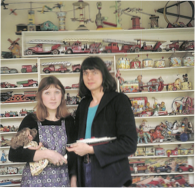ABOUT US
How it began
In the fifty's, my parents had a business of repairing toys and dolls.
The dolls were brought in by weeping little-girl-mothers and the tin toys by vans of the big warehouse stores.
My mother took care of the dolls and plush toy-animals, my father and his staff of the metal crates with mostly tin toys, imported from Germany, Japan or England with some kind of defect.
Sometimes I could make myself useful and this was remunerated with one of these toys. In this way I came intensively in contact with tin toys in all its varieties.
But the real interest came when I was studying at the art-academy and regarded them in a different way. In concept and appearance they were true little industrial art-pieces.
In my girlfriend I met a great ally in our search of toy shops where these pieces could be found in back-store dusty places. Tin toys, dolls of all materials, rare wooden and celluloid toys were gathered in this way. All in -No-Played-With- shape and some in the original boxes.
It has become a collection of which experts assert that it is a trusty reflection of the years just before and after WW II in northern Europe, worth a museum and which may certainly be denominated as "antiques"
The decision
The end of collecting toys came for us when the original sources (The old Toy Shops) went dry and to obtain more, one had to rely on auctions or fellow collectors. And now, after so many years enjoying this large and beautiful collection, we have decided to sell it.
When some serious negotiations of selling the entire collection had failed, we explored the possibilities to sell by lots or pieces.
We started to sell through International Auctions, which on the average went well, but we also explored the possibilities the Internet offers in respect. In this matter eBay has turned out to be an excellent tool, not only for selling, but also for getting sight on prices and demands.
More than 6 years are we scanning now the Internet for identical items sold and this has remained in an huge database covering some 80% of items corresponding to what we have in our collection. The other 20% we have never seen, what might mean that these pieces are extremely scarce.